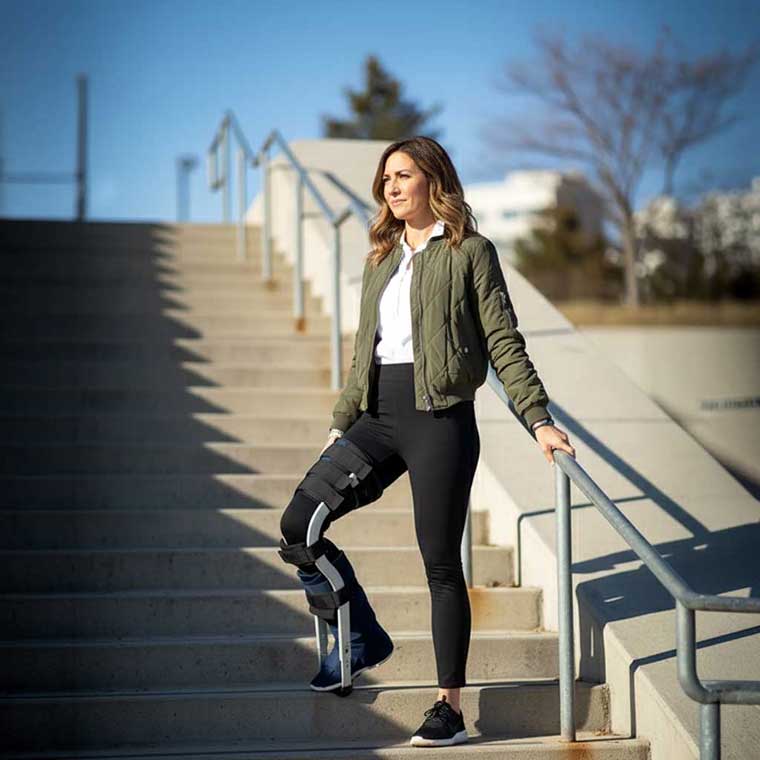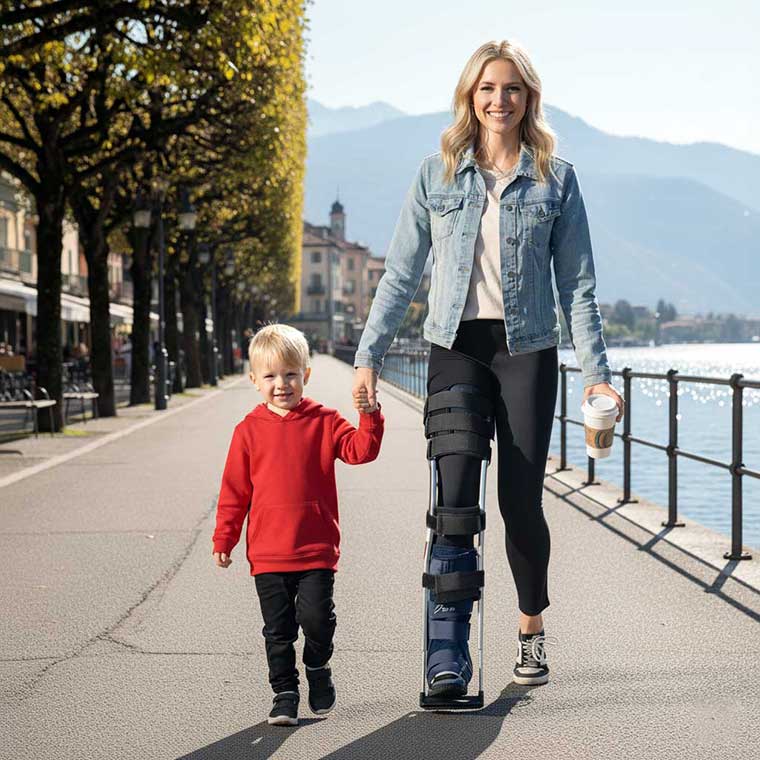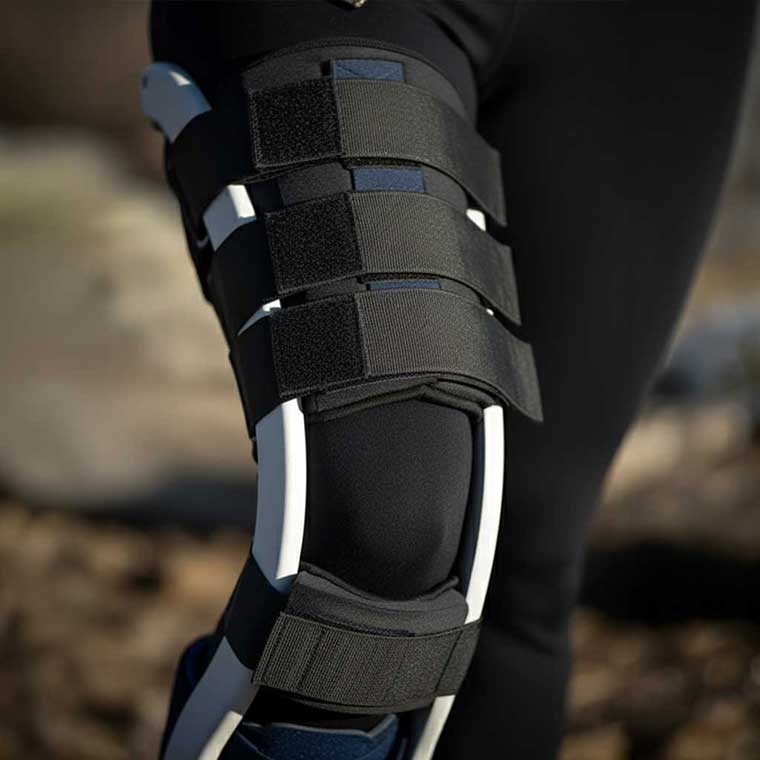After two weeks of daily use, my Freedom Leg 3.0 hands free crutch review lands at an 4.2 / 5. If you need both hands free during strict non weight bearing recovery, it is the most practical option I have tried.
I tested it on stairs, in the kitchen, and around the house to see where it shines and where it struggles.
- How I tested: 2 weeks of strict non weight bearing after foot surgery.
- Daily home use with stairs, kitchen tasks, and short outdoor walks.
- Compared against underarm crutches, iWalk, and a knee scooter.
- Best for: multi-story homes and strict non weight bearing recovery.
- Not ideal for: shaky balance or very short use periods.
- Score: 4.2 / 5 after two weeks of hands free crutch testing.
Best for
- Homes with stairs where crutches feel sketchy.
- Kitchen and household tasks where you need both hands.
- People who already dislike underarm crutches and want a different load path.
Skip it if
- Your balance is shaky or you already rely on a cane or walker.
- Your surgeon allows partial weight bearing in a boot.
- The price tag is a stretch and you only need a week on mobility aids.
- Hip or thigh issues on the injured side make load transfer risky.
- You have frequent dizziness or balance problems.
Transparency note: I tested this brace independently for two weeks. If you buy through links on this page, I may earn a small commission at no extra cost to you. It keeps the site running and does not change what I write.
Freedom Leg 3.0 hands free crutch review, first impressions
The Freedom Leg 3.0 straps around your thigh, knee, and calf to shift weight up to your hip so your injured foot never touches the ground. On day one it felt weird and a little sketchy. By day three, I could walk room to room without overthinking it. By the end of week one I was carrying a full coffee mug up the stairs—something I would never risk on crutches.
I have tested a depressing number of mobility aids: basic underarm crutches, the iWalk hands free crutch, multiple knee scooters, and upgraded underarm crutches like the M+D Air. If I would not recommend it to a friend stuck on the couch after surgery, it does not make the cut.
What problem it solves
- You must stay fully non weight bearing for weeks, not days.
- Your home has stairs or tight corners where a scooter is a pain.
- You hate underarm crutches tying up your hands.
Freedom Leg 3.0 overview and key specs
What comes in the box
- Main brace with aluminum frame and padded thigh/knee rests.
- Four adjustable straps (two thigh, one calf, one ankle area).
- Printed instruction sheet with fitting diagrams and warnings.
- Sizing guide plus support contact info.
- Height range: roughly 4'10" to 6'4" (long thighs fit best).
- Weight capacity: up to about 300 lbs.
- Materials: lightweight aluminum frame, dense foam padding, thick nylon straps.
- Weight transfer: loads the thigh/hip on the injured side so the foot stays off the ground.
Fit notes and body type quirks
- If you are under ~5'0": the frame can sit awkwardly; double check thigh length with the brand before ordering.
- Very short thighs: you may feel the thigh pad edge closer to the knee; ask for exact pad dimensions and where it should sit.
- Very long thighs: usually the best fit; make sure the upper straps can sit high enough without rubbing the groin.
- What to ask the manufacturer: maximum thigh circumference at the strap locations and the distance between thigh pad and knee cup.
Price and value
Most listings put the Freedom Leg 3.0 at $299 to $349. That is steep versus basic crutches but makes more sense if you are staring at six to eight weeks of strict non weight bearing life. Some insurance plans reimburse it as durable medical equipment—check first.
Design, fit, and build quality
In person it looks more “robot leg” than the photos suggest. The aluminum frame sits off the side of your leg and is noticeable. Loose sweatpants or joggers work; skinny jeans do not. Build quality feels solid: no flex in the frame, dense padding that does not bottom out, and straps that feel like medical gear rather than costume parts.
Comfort: the thigh pad takes most of the load. Expect 30–60 minutes before that area wants a break. A thin compression sleeve under the thigh contact area helped with rubbing and sweat for me.
Durability: after stair sessions, outdoor walks, and many bump-ins with door frames, there were no dents and the Velcro still grabbed hard.
How it actually moves in daily life
- Kitchen: huge upgrade over crutches—carry a pot, open the fridge, move between stove and sink without juggling sticks.
- Stairs: biggest win. With a rail, I felt far more controlled than on crutches, taking one step at a time with the injured foot lifted.
- Flat ground: predictable on driveways and sidewalks; thigh burns sooner on mild uphills and I slow down on downhills.
- Tight spaces: more maneuverable than a scooter, but wider than you think—door frames will remind you.
You are still walking on one leg with extra hardware. Indoors felt stable after a few days. On slopes or shiny floors I slowed down and respected it.
Fitting and troubleshooting
- Setup time: 15 minutes on day one, then 3–5 minutes once you know the order.
- Strap order that worked: upper thigh → lower thigh → knee → calf/ankle last.
- Sliding down: move the pad higher and tighten thigh straps gradually.
- Numbness or tingling: loosen slightly and take a break.
- Knee cap pain: center the knee on the platform.
Daily usability
Most days I used it in 45–60 minute blocks: morning kitchen, mid-day chores or standing desk, and sometimes an evening session. For ten-step bathroom trips I still grabbed crutches; for long flat distances a knee scooter was easier. Noise is low (soft tap on hard floors). Clothing is the bigger issue—plan on looser pants.
Freedom Leg 3.0 versus other options
iWalk hands free crutch
Lighter and faster to put on, but the bent knee position gets old after 30 minutes. Freedom Leg lets your leg hang straight and felt safer on stairs. Flat homes and tight budgets favor iWalk; stair-heavy homes favor Freedom Leg.
Standard underarm crutches
Underarm crutches are cheap and familiar but tie up both hands and punish your armpits and wrists. Freedom Leg is not a total replacement, but it is the best way I have found to get hands back during longer, hands-on tasks. If you are choosing a pair, see what to look for when buying crutches for fit and comfort tips.
Knee scooter
Excellent for long flat runs and stores, useless on stairs and annoying in tight bathrooms. I like having both: scooter for distance, Freedom Leg for stairs and kitchens. For options, see best knee scooter reviews.
| Feature | Freedom Leg 3.0 | iWalk | Knee scooter |
|---|---|---|---|
| Price | $299–$349 | $150–$180 | $100–$250 |
| Hands free | Yes | Yes | Yes |
| Stairs | Very good with a rail | Awkward | Not usable |
| Comfort for 1 hour | Good, thigh gets tired | Fair, knee gets tired | Excellent on flat floors |
| Learning curve | Moderate | Moderate | Low |
| Tight spaces | Good | Very good | Poor |
Pros and cons after two weeks
What I liked
- Hands free mobility for chores and stairs.
- Stairs feel controlled compared to underarm crutches.
- No armpit or wrist pain at the end of the day.
- Frame and straps feel solid under load.
- More compact than a scooter in tight hallways.
- Quiet on most floors.
What could be better
- Thigh pressure builds after 45–60 minutes.
- First few days feel unstable.
- Bulky under fitted pants.
- Requires decent balance and leg strength.
- Premium price.
- Padding runs hot on longer sessions.
- Not worth putting on for tiny trips.
What is new in the 3.0 version
Thicker thigh pad, stronger straps, and clearer instructions make 3.0 feel like a mature product. Breathability and finer tuning for different thigh shapes are the main areas I would still improve.
Buying advice before you order
Quick pre-purchase checklist
- Your surgeon wants you fully non weight bearing on one foot for more than a week.
- You can stand comfortably on the good leg without another aid.
- Your home has stairs or tight spaces where a scooter struggles.
- You are willing to learn a new device for a few days.
- You can afford it or have a realistic shot at reimbursement.
Best fit scenarios
- Post-op foot and ankle surgery: bunion surgery, Achilles repair, ankle fractures.
- Multi-story homes: daily stairs feel far more practical with this than crutches.
- Parents and caregivers: having both hands free changes the math.
- People who cannot stand crutches: if underarm crutches already failed you, this is the most interesting alternative.
When to choose something else
- Partial weight bearing allowed: boot plus crutches or a cane may be simpler.
- Major balance or strength issues: consider a walker or wheelchair instead.
- Long distance daily walking: a knee scooter will leave you less exhausted.
- Very tight budget: basic crutches are not glamorous but are serviceable.
Where to buy the Freedom Leg 3.0
- Official Freedom Leg site: best for current models, warranty, and support.
- Amazon: often available with fast shipping; verify the seller is authorized.
- Online medical retailers: many mobility shops carry it.
Insurance tip: call your insurer and ask about reimbursement for hands free mobility devices as durable medical equipment. Get the documentation list before you buy and keep every receipt.
Freedom Leg 3.0 FAQ
No. The padding will soak up water and take ages to dry, and repeated soaking can damage it. Take the brace off before showers or baths.
About 15 minutes on day one while you learn the straps; 3–5 minutes once you know the order. Taking it off is quicker.
It fits over loose sweatpants or athletic pants. Fitted pants will bunch and pull; I lived in “Freedom Leg friendly” clothes during testing.
With a solid handrail it felt controlled. I went step by step, always leading with the good leg, and kept the injured side off the ground. I would not try stairs without a rail or while rushing.
Some plans reimburse a portion if your doctor writes a prescription. Call your insurer, ask about coverage for hands free mobility devices, and follow their paperwork exactly.
Around 3–4 pounds. You feel the load on your thigh more than as a weight in your hands; fatigue comes from pressure, not lifting.
If your right foot is injured, the safe answer is no. If your left foot is injured and you drive an automatic, ask your surgeon first—the brace is bulky and can press into the seat. Also read driving with a boot and crutches for safety tips.
I would not. The straps dig in and rolling onto it can put odd pressure on your leg. I always took it off before bed and used crutches for night bathroom trips.
Final verdict
Bottom line: the Freedom Leg 3.0 is not a universal crutch replacement, but if you are living in a multi-story home and need both hands free, it earns its place. Expect a learning curve and thigh soreness, not a miracle.
Photos and real world feedback
Image note
These are my own photos from testing the Freedom Leg 3.0 at home and on the stairs.




What many people like: being able to handle stairs without feeling one slip away from disaster and moving around the house without dragging crutches everywhere.
What people struggle with: the learning curve in the first few days, thigh pressure, and figuring out clothes that fit over the brace.
Important: Always clear any new mobility device with your surgeon or physical therapist. This is for strict non weight bearing recovery. If you feel unstable, dizzy, or in sharp pain, stop and talk to your clinician.
